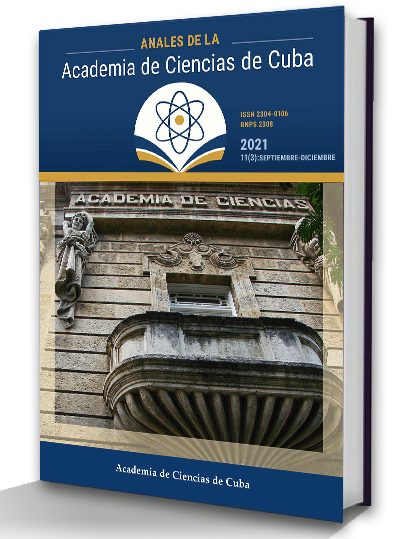Scientific works of the Cuban Academy of Sciences in Web of Science over the period 1995-2020: bibliometric study and network mapping
Keywords:
Cuban Academy of Sciences, period 1995-2020, bibliometrics, scientific production, collaborative networksAbstract
Introduction: This paper addresses the analysis of the scientific production of the Cuban Academy of Sciences (ACC) with the use of bibliometric tools, in the period from 1995 to the present, stage where the institution, from Decree Law 163 of 1996, begins to function as a consulting and advisory entity for the Cuban Estate in science, technology and innovation.Methods: The data used for the analysis come from all the documents published in the Web of Science in the study period. Bibliometric indicators such as Price's law of growth of the scientific literature, Lotka's law, the transience index and the Bradford model were applied to explore the production, dispersion, distribution and annual growth of documents. The use of bibliometric cartography allowed for the exploration of the co-occurrence networks of the most used terms in the articles and the obtaining of strategic diagrams. The study is complemented by the calculation of the participation rate of the different countries and institutions in ACC publications. Finally, through bibliometric cartography, we have explored the co-occurrence networks of the most used terms in documents generated by the ACC and made strategic diagrams.
Results: Unlike the stage between 1968 and 1994 analyzed in a previous publication, where scientific production was better adjusted to an exponential behavior, in this stage the adjustment corresponds to a greater extent to a linear growth (r = 0.6111), recovering 169 articles. The transience index is increased to 80.33 %, which indicates that the generation of most of the scientific production continues to be concentrated in very few authors. The co-authorship rate was 2,89. The core of Bradford is made up exclusively of Mycotaxon journal. The State University of Feira de Santana (as an institution) and Brazil (as a country) show the highest rates of collaboration with the ACC. The bibliometric mapping visualization shows the map of closely related terms. Conclusions: In this stage, a deterioration of the bibliometric indicators of the scientific production of the ACC is evident with respect to the previous stage. The growth of the scientific literature of the ACC was linear for the period studied, which confirms the breach of Price's law of growth of the scientific literature, not observing a growth saturation point. On the other hand, the transience rate is very high, which indicates the presence of numerous authors who published sporadically with affiliation to the ACC. During this period, there is an abrupt change in the ACC's research topics with respect to the previous period.
Downloads
Downloads
Published
How to Cite
Issue
Section
License
The journal Anales de la Academia de Ciencias de Cuba protects copyright, and operates with a Creative Commons License 4.0 (Creative Commons Attribution-NonCommercial License 4.0). By publishing in it, authors allow themselves to copy, reproduce, distribute, publicly communicate their work and generate derivative works, as long as the original author is cited and acknowledged. They do not allow, however, the use of the original work for commercial or lucrative purposes.
The authors authorize the publication of their writings, retaining the authorship rights, and assigning and transferring to the magazine all the rights protected by the intellectual property laws that govern in Cuba, which imply editing to disseminate the work.
Authors may establish additional agreements for the non-exclusive distribution of the version of the work published in the journal (for example, placing it in an institutional repository or publishing it in a book), with recognition of having been first published in this journal.
To learn more, see https://creativecommons.org






